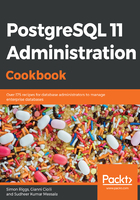
Introducing PostgreSQL 11
PostgreSQL is an advanced SQL database server, available on a wide range of platforms. One of the clearest benefits of PostgreSQL is that it is open source, meaning that you have a very permissive license to install, use, and distribute PostgreSQL, without paying anyone any fees or royalties. On top of that, PostgreSQL is known as a database that stays up for long periods and requires little or no maintenance, in most cases. Overall, PostgreSQL provides a very low total cost of ownership.
PostgreSQL is also known for its huge range of advanced features, developed over the course of more than 30 years of continuous development and enhancement. Originally developed by the Database Research Group at the University of California, Berkeley, PostgreSQL is now developed and maintained by a huge army of developers and contributors. Many of these contributors have full-time jobs related to PostgreSQL, working as designers, developers, database administrators, and trainers. Some, but not many, of these contributors work for companies that specialize in support for PostgreSQL. No single company owns PostgreSQL, nor are you required (or even encouraged) to register your usage.
PostgreSQL has the following main features:
- Excellent SQL standards compliance, up to SQL: 2016
- Client-server architecture
- It has a highly concurrent design, where readers and writers don't block each other
- It is highly configurable and extensible for many types of applications
- It has excellent scalability and performance, with extensive tuning features
- It offers support for many kinds of data models, such as relational, post-relational (arrays, nested relations via record types), document (JSON and XML), and key/value